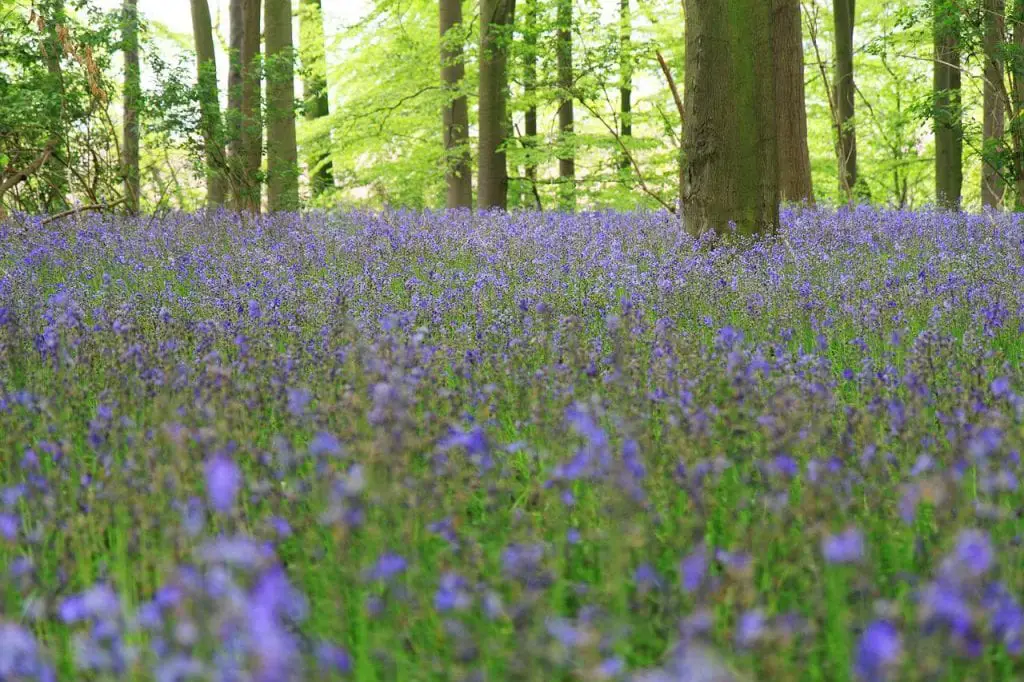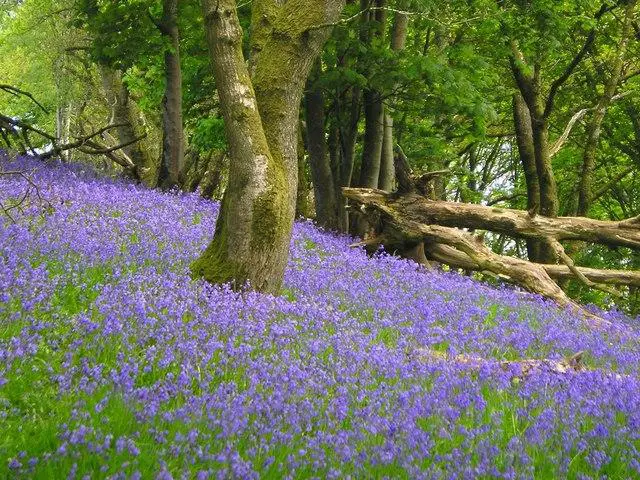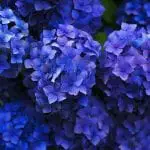Visiting the United Kingdom in spring is a specially quintessential experience. If you are a resident of the United Kingdom, you probably know why already. The cold winter gives way to light, pleasant nights, as summer is gradually closing in. Trees start sprouting leaves, flowers begin to bloom. The bare landscape of winter, with all its gray tones, gives rise to bursts of color in nature. No better sign of spring exists, than seeing bright, beautiful things that are blue in many British gardens. British Bluebells are ready to make their appearance felt once more.

Throughout the wilderness that Britain is so famous for, in woods and forests, you will discover bluebells. Bluebell woods of the United Kingdom are famous the world over. You may not notice them, though, till the bluebells bloom. To get a fill of the magnificent endless stream of flowers, you have to be in the UK in spring, for a brief period. You don’t have to travel to the far corners of the countryside, though this appeals to many tourists, to see the wonderful flowers. Near London, in Essex, famous not least for its zoo in Colchester, you will discover the humble British Bluebell (English Bluebell) in the thousands! There are woods that you can walk through and take in the full variety of superb flowers that poets have written about.
Bluebell Woods, UK, comprise woods where these flowers thrive. They are present in many parts of the United Kingdom, and are owned by the National Trust or the Woodlands Trust of the UK. Bluebells are as common to the country as the Big Ben and the Tower of London are. You will see bluebells in many areas, other than the woods themselves, such as in hedges next to old trees.
British Bluebells
Glorious things that are blue are the British Bluebells in the Bluebell Woods of the United Kingdom. The common bluebell is a spring flower, and its flowering time is just a week or so, sometimes. In Britain, you will find bluebells in April and May. Ideally, you should follow weather information as warm winters see than blooming earlier than usual. It is interesting to note that more than half of the world’s bluebells grow in the UK. When bluebells grow by way of seeds planted, it may take as long as five years to see a bulb come up.
British bluebells are of the species Hyacinthodes non-scripta. This particular bluebell variety was discovered by a Swedish botanist, Carl Linnaeus, in 1753. Bluebells, ironically, are not really things that are blue. The flower has a deep rich violet hue. At a glance, when you see them packed together in clusters of flowers, they do tend to look deep blue. Many grow on a single stem and droop downwards like a bell. Bluebells can sexually reproduce through seeds or asexually, by way of natural propagation. If you crush a bluebell, it will die as its leaves cannot go through photosynthesis to make food for the plant.
British Bluebell Facts
Here are some interesting facts that relate to the flowers you will see in many of the Bluebell Woods in the UK:
- When you visit a Bluebell Wood anywhere in the UK, you will no doubt be blown away by the sight of the pretty things that are blue. Nonetheless, don’t get so carried away that you want to pluck some flowers out of their natural home. It is illegal to pick, uproot or destroy bluebells in all parts of the UK. The flowers are secured under the Wildlife and Countryside Act (1981) that prohibits acts of destruction to the blooms. You could be levied a fine of nearly 5,000 British Pounds FOR EACH BULB. Conducting trade in wild bluebell flowers is also taken as an offense as stated by the same act.
- Bluebells first appeared on earth nearly 11,500 years ago, in the Ice Age. Glue made from bluebells was used in bookbinding in the UK. The glue has toxic properties, preventing pests from destroying paper.
- In the Bluebell Woods, UK, you will encounter two kinds of flowers. One is the British Bluebell and the other is the Spanish Bluebell. British flowers are delicate, while their Spanish cousins are vigorous and robust. You may come across a rare white bluebell. White bluebells lack the blue pigment.
- The Bluebell Woods of the UK are infested with as many bees as there are bluebells. Bees and wasps love the nectar of these particular bluebells. If you get up close to a bluebell, you might notice a clean hole in the bluebell bottle – bees have likely bitten it to steal the nectar!
- When you cast your eyes upon these lively things that are blue in any of the Bluebell Woods in the UK, have a care. Bluebells are poisonous to humans, cattle, horses and dogs. Touching the plant may give rise to contact dermatitis, and ingesting it will cause vomiting, diarrhea and lowering of the pulse rate.
British Bluebell Woods
Native British bluebells come out in all their hues from powder to deep blue and rich violet in April and May in some of the most ancient woodlands. The United Kingdom bluebells, and most grow in the Bluebell Woods, UK, account for fifty percent of the world’s bluebell population! That’s a load of bluebells for you!
Several of the woods tended to by the Woodlands Trust contain carpets of bluebells as far as the eye can see. When you visit these woody havens, you will have full access to paths that go through the area. There are also amenities such as wheelchair access and public toilets. Some woody areas have eateries too. The well known woodlands run by the Trust are:
- Costells Wood, Sussex
- Ashenbank Wood, Kent
- Duncliffe Wood, Dorset
- Greyfield Wood, Somerset
- Old Wood, Norfolk
The National Trust of the UK maintains some great bluebell woods too. The following are worth a visit:
- Sheffield Park and Garden, East Sussex
- Little Wix Wood, Surrey
- Hinton Ampner, Hampshire
- Clivedon, Buckinghamshire
- Hughendon Manor, Buckinghamshire
Famous British Woods
A visitor to the UK doesn’t have to go miles in search of the most refreshing and lovely bluebells around. In terms of quality and quantity, they astound you and are a feast for the eyes. For instance, at Sheffield Park and Garden, you can see them in all their glory. These lovely things that are blue have been growing here since the 1700s. You can go down the prescribed pathways, or don a pair of wellies and explore. Just don’t tread on them! An untouched woody area called “Walk Wood” is a tranquil place to get off the beaten track.
Little Wix Wood in Surrey is an ancient woodland, where paths are narrow. It has all the old world charm of something out of a movie set. Come spring every year, you will see the inviting sight of patches of daffodils as well as new bluebells. The contrasting colors of these things that are blue with other spring blooms are charming and you can’t take your eyes off the scene. The gardens of the park, Hatchlands Park, adjoining the wood are pleasurable. From the garden, you will get a view of the nearby Gason Wood in full bloom. As you walk through the woods, keep an ear out for songbirds like chiffchaffs and nuthatches.
Greyfield Wood in Sommerset is a 90-acre wood, with a great amount of old wooded area and new planted land. It once comprised of the hunting estate of the Earl of Warwick. The wood has two stone-surface pathways and a lot of rustic rough paths that shoot off at intervals. Many tried and tested footpaths exist and there is an inviting waterfall nearby too. This is a large habitat for bluebells to grow freely, along with interspersed streams and other flora and fauna. Besides the beautiful things that are blue, you will discover trees like Ash, Oak, Fir, Chestnut and Birch. A natural ecosystem for birds like the Blue Tit, Woodpecker, and Buzzard, the wood is a place of enchantment. The bluebells make it look magical.
Historical Woods
Several Bluebell Woods in the UK are historical in nature, and they have legend and stories at their background. For instance, this is truth not legend, in Elizabethan times, when ruffed collars were in vogue, Queen Elizabeth I had estates in England provide bluebells to make starch. The starch from the bluebells made the collars stiff. Many people in the same period had the belief that bluebells were associated with fairies. Children have always been in a state of wonder when they witness these enigmatic things that are blue. People used prevent their children from wandering off into the private estates of barons and lords (that were almost always attached to a bluebell wood). They were sure that these were enchanted places of mystery and magic. Legend had it that if children heard bluebells ringing, they would die within a year.
British Literature
The Bluebell Woods, UK, have been a great source of inspiration for British novelists and poets, from Emily Bronte to Alfred, Lord Tennyson. In 1871, noted English poet, Gerard Manley Hopkins wrote of bluebells in a bluebell wood in an entry in his diary. He said, “The bluebells in your hand baffle you with their inscape, made to every sense. If you draw your fingers through them they are lodged and struggle with the shock of wet heads…”



